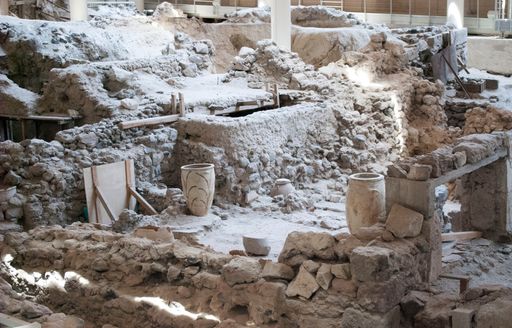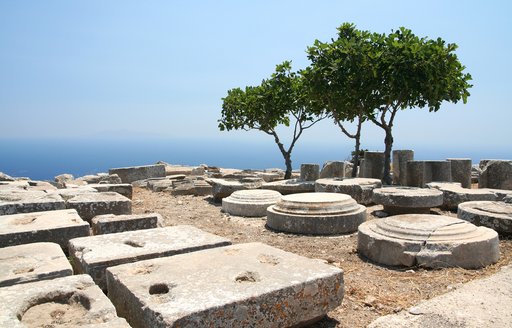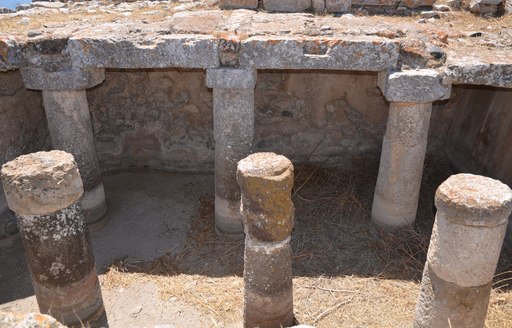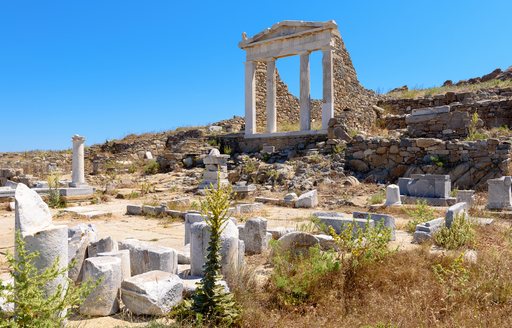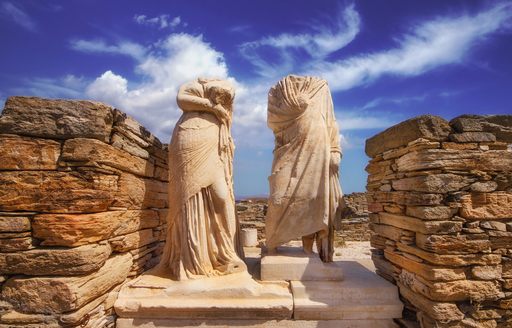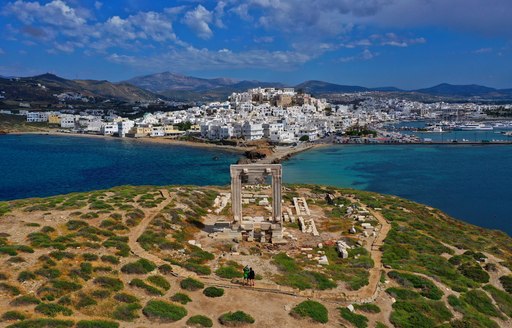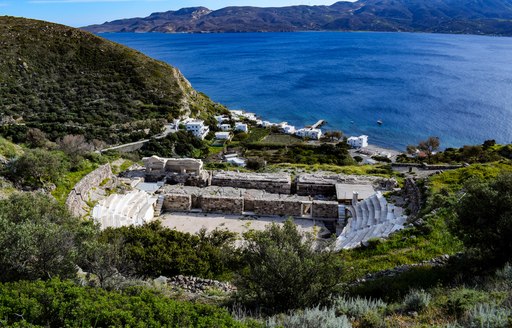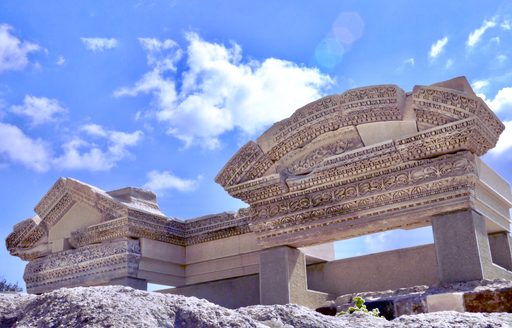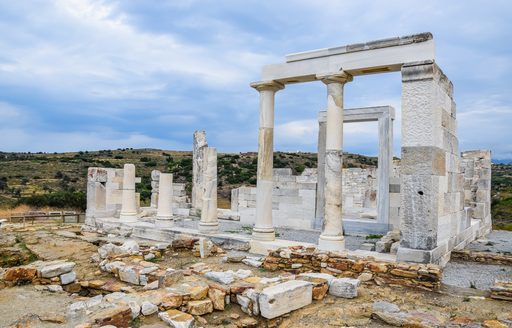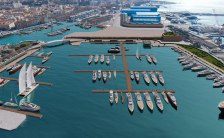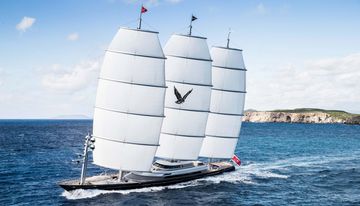On a Greece yacht charter vacation, you'll find some of the country's most important archaeological sites around the Cyclades island chain. One of the most enchanting and rewarding destinations in the Mediterranean, Greece is home to a diverse mix of islands where you will find an array of awe-inspiring monuments from the ancient world.
In the heart of the Greek cruising grounds lies the Cyclades, a necklace of islands made up of Santorini, Mykonos, Naxos, and a host of other popular destinations ideal for crewed yacht charters.
It is here that evidence of the Golden Age of Ancient Greece is the most apparent. Scattered across these islands are a myriad of fascinating landmarks and attractions that are well worth visiting when you explore the Cyclades by yacht.
Here are just a few ideas to add to your itinerary.
Located in the southwestern corner of the island of Santorini, the remarkably well-preserved ancient site of Akrotiri dates back more than six thousand years, to the age of the Minoan civilization.
The town was destroyed during a massive volcanic eruption in around 1500 BC, when it was engulfed in ash. The ash covering had the effect of preserving many of the buildings, as well as frescoes, pottery and organic material including wooden furniture.
Excavations began the 1960s, and they have uncovered a surprisingly sophisticated settlement, with two-storey houses, paved streets and an advanced drainage system, leading some to associate Akrotiri with Plato's Atlantis.
-
Akrotiri
Museum
In the north of Santorini is another important archaeological site, that of the ancient city of Thera. Occupying a dramatic clifftop location overlooking the Aegean Sea, the extensive ruins are an impressive reminder of what was once a prosperous and vibrant settlement.
What remains today dates largely from the Roman period, the 1st and 2nd centuries AD, although Thera's origins go back as far as the 9th century BC.
Among the highlights of ancient Thera are the 2nd century AD theatre, which could seat 1500 spectators, the large agora, and the collonaded walkway of the town's basilica.
Artefacts from the site can be seen in the Archaeological Museum in Santorini's capital, Fira. Several important finds have been unearthed here, including a magnificent 6th century BC statue of a kouros, which is now on display in the National Museum in Athens.
The tiny island of Delos, just off the western coast of Mykonos, was an important religious centre in antiquity, held sacred as the birthplace of the god Apollo and his twin sister Artemis. Now a UNESCO World Heritage Site, it is one of the most important archaeological sites in Greece.
The intriguing remains of ancient temples, public buildings and statues dot the landscape, but among the most famous sights is The Terrace of the Lions, an avenue of seven marble lion statues which line the Sacred Way.
Take time to visit the House of Dionysos, a private dwelling known for its exceptional floor mosaics, stop by the impressive Temple of the Delians and walk the floors of Synagogue, which is thought to be one of the oldest in existence, dating back to the 2nd century BC.
Delos is an unmissable port of call on any Mediterranean yacht charter around the Cyclades, and the ruins of this ancient pilgrimage can be easily seen from the comfort of your yacht.
-
Delos (Dhílos)
Landmark
An imposing symbol of the island of Naxos, the Portara is a gigantic stone gateway towering on a hilltop near the harbour. It is all that still stands of a temple to Apollo, which was started in 530 BC by the tyrant Lygdamis but was never completed.
The Portara is located on the islet of Palatia and is joined to Naxos by a short causeway. This islet is steeped in legend, as it is the mythological site where Theseus abandoned Ariadne, daughter of King Minos, after he killed the Minotaur.
Standing on the cliff overlooking the port, this unmistakable ancient monument is the first thing you will see as you approach Naxos on your yacht. It provides a breathtaking setting for viewing sunsets and sunrises, providing one of the iconic views of Greece.
-
The Portara of Naxos
Attraction
The island of Milos is known as the site where the Venus di Milo was first discovered and subsequently transported to the Louvre in France, which gives some indication of the cultural significance and heritage of this rocky Greek outpost.
The island is also known for its sea-facing Roman-style theatre. Constructed originally in the 3rd century BC in a prominent location overlooking the port, and later rebuilt in Parian marble by the Romans, the theatre on Milos could once accommodate some 7000 spectators, who came here to celebrate festivals and to watch drama and music performances.
The theatre has been carefully restored in recent years, and once more hosts concerts and plays during the summer, a memorable experience if you are here at the time.
Elsewhere on Naxos, the Temple of Demeter stands imposingly. Dating back to 530 BC, this temple is thought to be one of the oldest which honours the goddess Demeter, ruler of grains.
The temple's architecture is similar to other sites of Worship of the era, with classic ionic columns made of marble which support a flat structure sitting atop. Interestingly, the temple was thought to have been converted into a church in the 6th century, as Christianity began to take ahold of Greece.
Lying mostly in ruins, the Temple of Demeter was discovered by modern archaeologists in 1949. Excavation works took place in the 1990s, restoring the temple to the fascinating site it is today.
-
Temple of Demeter
Landmark
If you would like to include any of these culturally rich monuments and heritage sites into your itinerary, please speak with your prefered yacht charter broker.

Feeling inspired?
You can view and compare the entire fleets of superyachts available to charter in the Mediterranean.
Take a clook


